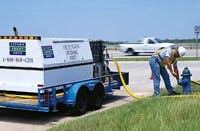With sections of its water main system more than 100 years old, the village of Ripley, Ohio had a problem common to many municipalities in the east and midwest, the roughness of the inside of the system's pipes that had been caused by years of use was responsible for occasional flow capacity and water quality problems.
Ripley is a town about 50 miles southeast of Cincinnati along the Kentucky border. The village's water comes from a groundwater source containing manganese, which would slowly precipitate out in a black sediment.
During times of peak loading sediment in the distribution system would be disturbed and appear at points-of-use. This is not an uncommon situation, particularly in older water main systems. While the water quality was in compliance with local regulations, the village of Ripley was not satisfied to merely "meet code".
Instead, the village began investigating a cost-effective method of cleaning their water main system as an alternative to replacing entire sections of the system.
The two most common methods of water main cleaning are flushing or "pigging" and both methods have drawbacks.
Flushing requires that an enormous quantity of clean water be flushed through the system by means of unidirectional flushing (UDF). If sufficient scouring velocities cannot be achieved, flushing will not be effective. Pigging, or physically passing a swab through the main, is quite costly.
The disassembly and reassembly of the fire hydrants to introduce the swab into the section of the main to be cleared is time consuming. Pigging also is limited in its application, as it cannot be performed on mains that include butterfly valves.
An alternative method of water main cleaning
Air scouring is a patented method of water line cleaning in which a section of the water main between an entry point and exit point (typically fire hydrants) is isolated, and the section is purged of standing water with high-volume, high-velocity and low-pressure air.
Slugs of water are then produced when the valve upstream of the entry point is opened slightly, allowing the passage of controlled amounts of water into the section. The compressed air, mixing with the water slugs, creates a vortex that travels through the isolated section removing sediment, biofilm and soft mineral scale. When water exiting the line is clear, service is restored to the section.
The primary benefit of air scouring is the removal of sediment, thus improving water quality. But often, flow capacity also can be significantly increased. In addition, air scouring has proven to be a more viable, cost-effective solution‹generally, about one-third the cost of pigging.
Prior to air scouring, loss of head tests may be performed using the Hazen-Williams "C" value test, an empirical formula used extensively in the design of water supply systems.
The test determines the coefficient "C" that represents the internal friction of the pipe. As water flows through a pipe, head losses (i.e., pressure losses) occur due to friction. The amount of head loss will vary depending on the diameter of the pipe, the rate of flow and the roughness of the pipe wall.
The roughness coefficient is a function of the condition of the inside of the pipe. Values range from 80 or less for old, unlined and tuberculated pipe up to 140 for very smooth pipe.
In a modified form, the Hazen-Williams formula can be expressed as follows:
CH-W = (42.73 x Q) / (d 2.63 x f 0.54)
- * CH-W = Hazen-Williams roughness coefficient
- * Q = Flow in gallons per minute
- * D = Inside diameter of the pipe in inches
- * f = friction head losses in feet per hundred feet of pipe
The head loss test measures the friction head losses (f ) for a known high rate of flow (Q) through a section of pipe. With these two values, and knowing the inside diameter of the pipe, the CH-W factor can be calculated using the Hazen-Williams formula.
Prior to air scouring, an initial Hazen-Williams "C" test on the village of Ripley water main system showed a coefficient of 67 for the chosen section of 8-in. pipe.
During the air scouring procedure a scouring velocity of approximately 20 ft per second was achieved‹far greater than typical flushing velocities. The air scouring process removed manganese build-up along with other loose tuberculation inside the pipe throughout the 15,000 ft of water main.
Immediately following the air scouring procedure, a second head loss test was performed. The Hazen-Williams value after air scouring was 96‹a significant improvement that increased flow rates to the same or higher levels than pigging would have, but for a fraction of the cost.
Village of Ripley, Ohio Head Loss Information
Flow (gpm): 650
Distance (ft): 422
Before Air Scouring
Head Loss (ft): 11.9
Slope (ft/1,000 ft): 28.2
C-Factor: 67
After Air Scouring
Head Loss (ft): 6.2
Slope (ft/1,000 ft): 14.7
C-Factor: 96
… Gpm: gallons per minute
… Distance: the distance between the two hydrants where the air scouring procedure took place
… Head loss: the more feet, the more friction.
Benefits of Air Scouring
Municipalities can realize one or more of the following benefits through air scouring:
- Costs as little as one-third the cost of pigging or swabbing;
- Uses far less water that UDF (Unidirectional Flushing);
- Eliminates the need for temporary ground piping to provide service water, reducing costs;
- Cleans all wetted parts of each valve, allowing for ease of future operation;
- Requires operation of valves and curb stops, helping to identify poorly functioning components so that they may be scheduled for repair or replacement; and
- Provides cleaner mains allowing better flow, reducing pumping costs, eliminating discolored water, and improving disinfection control.


